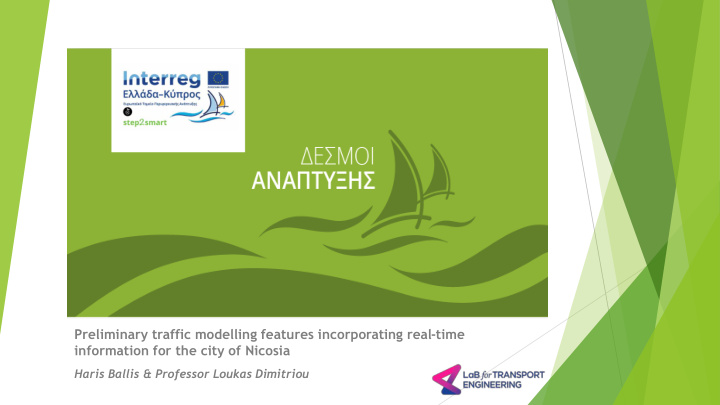



Preliminary traffic modelling features incorporating real-time information for the city of Nicosia Haris Ballis & Professor Loukas Dimitriou
Step2Smart (General Objectives) “The main objective of Step2Smart is to create an Open Interoperable Architecture System for Urban Transport Management and Measurement of Environmental Impact. ” The objective will be met through the application of pilot projects concerning Intelligent Transport Systems (ITS). The general direction of the plots will be to link transport to cities by reducing environmental pollutants. More precisely specific actions will help to reduce road delays and achieve measurable reductions of pollutants by improving traffic management informing users and network operators promoting public transport
The traffic optimisation pilot One of the pilots considers the development of a framework able to handle optimally the traffic conditions in the urban road network of Nicosia (or any other similar urban centre). More specifically, different (and innovative) signalisation strategies to control traffic will be examined and evaluated. The goal is to quantify the benefits/disbenefits, both to the users as well as to the environment, of these strategies and to identify a solution that meets the objectives of the project.
Controlling the system Demand is an exogenous parameter and we have (almost) no influence over it. On the other hand, we can influence the signalling control system and design it in a way which can work towards the desired outcomes. The main lever we can adjust is the elapsed time between the different stages of the traffic lights signals.
The current state Most of the current signalling strategies (at least in Cyprus and Greece) rely on fixed-time traffic control systems. Sometimes fixed-time could vary depending on the time of the day but these adjustments are rarely adjusted to new conditions. Some junctions are controlled by more sophisticated, adaptive control systems (e.g. SCOOT) More advanced traffic optimisation concepts such as “green - wave” and bus pre-emption are not particularly wide-spread
Optimisation objectives Our efforts focus on the development a fully adaptive traffic control system , enabling the: optimisation of flow and minimisation of delays and waiting times improvement of environmental conditions through the minimisation of air pollutant emissions improving transit operations (e.g. bus preemption) The designed system will be able to utilise live-data provided by available sources (e.g. Diavlos & Prodromos) For instance, the signalisation control will be aware of the environmental conditions around the implementation area and will adjust accordingly to reduce the negative environmental effects caused by traffic.
Microsimulation in action Due to the advanced requirements for realism, the assessment will be based on a suitable microsimulation modelling framework. A capable and well-known microsimulation platform will be used to develop the model Apart from its built in capabilities we will exploit the Application Programming Interface (API) to develop a solution specifically tailored for the purposes of this project.
Signalling strategies (Open Loop) Fixed time signalling cycles Semi-actuated (e.g. depending on time of the day) Demand t = n t = n+1 System
Signalling strategies (Adaptive on demand) Smart Adaptive traffic signal control systems (e.g. SCOOT , SCATS, InSync, etc.) Demand t = n t = n+1 System Control
Signalling strategies (Adaptive on demand and users’ reaction) The suggested signalling control system will Take into account readings from air pollution sensors incorporate the reaction on users (drivers) be informed on real-time Demand User’s reaction t = n t = n+1 System Air pollution Control sensors
Evaluation In order to prove and evaluate the benefits of our approach, we will compare multiple controlling systems (signalisation strategies) to the one developed by our lab. Comparative analysis of all the different scenarios in terms of: Network conditions Travel times Waiting times Flows Etc. Environmental conditions Air pollutant concentrations
Expected output Improvements on travel times and reduction of environmental emissions are expected, nonetheless we are not able at this stage to quantify them. Benefits Reductions in: • Cleaner • Travel times environment • Waiting times •Users’ • Emissions satisfaction • Congestion
Innovative concepts Apart from the standard approaches (e.g. adaptive systems) more innovative ones will be evaluated Relevant literature has indicated that applying “ reinforcement learning ” methodologies could lead to significant benefits. Such an approach will also facilitate the discussion regarding centralised and distributed optimisation approaches
The examined corridor Georgiou Griva Digeni is a 4km stretch of road connecting the centre of Nicosia with the West part of the city. Traverses 4 signalised intersections More than 20,000 vehicles use this corridor daily It can get exceptionally congested in the peaks (average speed about 15km/h)
Recommend
More recommend